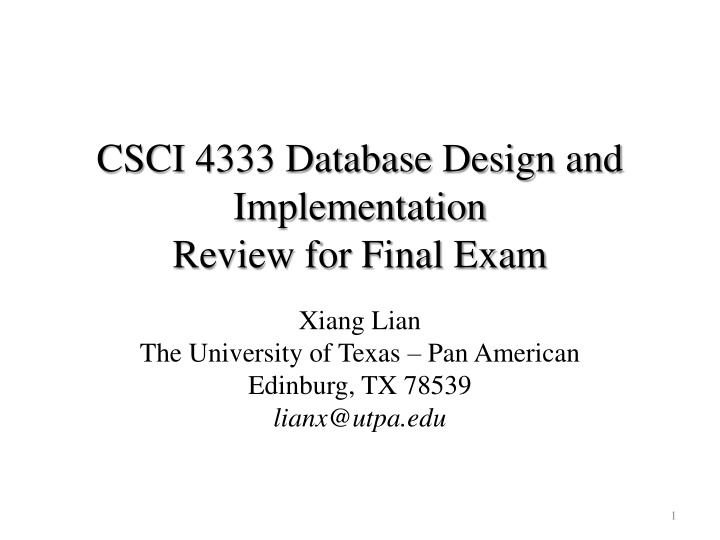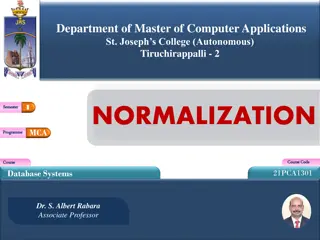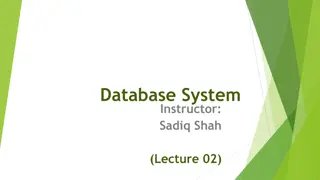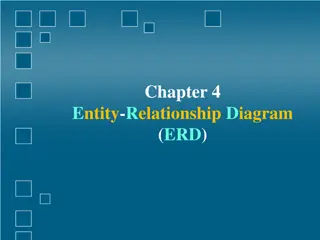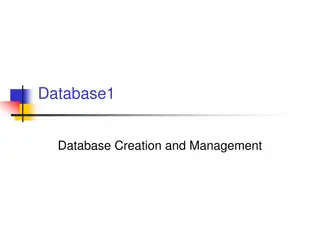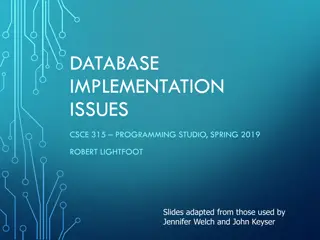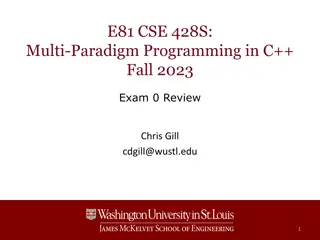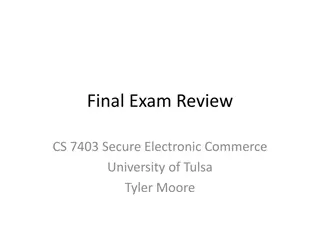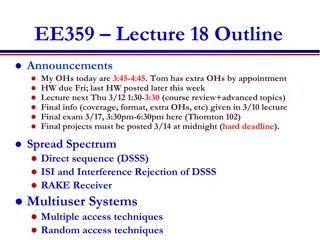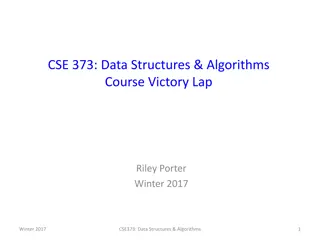Database Design and Implementation Review for Final Exam
Prepare for your final exam in CSCI 4333 by reviewing chapters 5, 6, 9, and 10 in your textbook, lecture slides, in-class exercises, assignments, and projects. Topics include relational algebra, SQL, normalization theory, query processing, and more. The closed-book exam will be held on December 11th, 8am - 9:45am at ACSB 1.104. Study well and good luck!
Download Presentation

Please find below an Image/Link to download the presentation.
The content on the website is provided AS IS for your information and personal use only. It may not be sold, licensed, or shared on other websites without obtaining consent from the author.If you encounter any issues during the download, it is possible that the publisher has removed the file from their server.
You are allowed to download the files provided on this website for personal or commercial use, subject to the condition that they are used lawfully. All files are the property of their respective owners.
The content on the website is provided AS IS for your information and personal use only. It may not be sold, licensed, or shared on other websites without obtaining consent from the author.
E N D
Presentation Transcript
CSCI 4333 Database Design and Implementation Review for Final Exam Xiang Lian The University of Texas Pan American Edinburg, TX 78539 lianx@utpa.edu 1
Review Chapters 5, 6, 9, and 10 in your textbook Lecture slides In-class exercises Assignments Projects 2
Review (cont'd) Question Types Q/A Relational algebra & SQL Normalization theory attribute closure, lossless decomposition, dependency preserving Physical data organization & indexing Heap file, sorted file, (un)clustered index, B+-tree, hash index Query Processing 5 Questions (100 points) + 1 Bonus Question (20 extra points) 3
Time, Location, and Event Time 8am - 9:45am, Dec. 11 (Thursday) Note: starting time: 8am, different from class time! Place ACSB 1.104 (classroom) Event Closed-book exam 4
Chapter 5 Relational Algebra and SQL Relational algebra Select, project, set operators, union, cartesian product, (natural) join, division SQL SQL for operators above Aggregates Group by Having Order by 5
Select Operator Produce table containing subset of rows of argument table satisfying condition condition (relation) Example: Person Hobby= stamps (Person) Id Name Address Hobby Id Name Address Hobby 1123 John 123 Main stamps 1123 John 123 Main coins 5556 Mary 7 Lake Dr hiking 9876 Bart 5 Pine St stamps 1123 John 123 Main stamps 9876 Bart 5 Pine St stamps 6
Project Operator Produces table containing subset of columns of argument table attribute list(relation) Example: Person Name,Hobby(Person) IdName AddressHobbyNameHobby John stamps John coins Mary hiking Bart stamps 1123 John 123 Main stamps 1123 John 123 Main coins 5556 Mary 7 Lake Dr hiking 9876 Bart 5 Pine St stamps 7
Set Operators Relation is a set of tuples, so set operations should apply: , , (set difference) Result of combining two relations with a set operator is a relation => all its elements must be tuples having same structure Hence, scope of set operations limited to union compatible relations 8
Union Compatible Relations Two relations are union compatible if Both have same number of columns Names of attributes are the same in both Attributes with the same name in both relations have the same domain Union compatible relations can be combined using union, intersection, and setdifference 9
Cartesian Product If Rand Sare two relations, R S is the set of all concatenated tuples <x,y>, where x is a tuple in R and y is a tuple in S R and S need not be union compatible R S is expensive to compute: Factor of two in the size of each row Quadratic in the number of rows A B C D A B C D x1 x2 y1 y2 x1 x2 y1 y2 x3 x4 y3 y4 x1 x2 y3 y4 x3 x4 y1 y2 RS x3 x4 y3 y4 R S 10
Derived Operation: Join A (general or theta) join of R and S is the expression Rjoin-conditionS where join-condition is a conjunction of terms: Ai oper Bi in which Ai is an attribute of R;Bi is an attribute of S; and oper is one of =, <, >, , . The meaning is: join-condition (R S) where join-condition and join-condition are the same, except for possible renamings of attributes (next) 11
Natural Join Special case of equijoin: join condition equates all and only those attributes with the same name (condition doesn t have to be explicitly stated) duplicate columns eliminated from the result Transcript (StudId, CrsCode, Sem, Grade) Teaching (ProfId, CrsCode, Sem) Teaching = Transcript StudId, Transcript.CrsCode, Transcript.Sem, Grade, ProfId (Transcript CrsCode=CrsCode AND Sem=Sem Teaching ) [StudId, CrsCode, Sem, Grade, ProfId] 12
Set Operators SQL provides UNION, EXCEPT (set difference), and INTERSECT for union compatible tables Example: Find all professors in the CS Department and all professors that have taught CS courses (SELECT P.Name FROM Professor P, Teaching T WHERE P.Id=T.ProfIdAND T.CrsCodeLIKE CS% ) UNION (SELECT P.Name FROM Professor P WHERE P.DeptId= CS ) 13
Chapter 6 Relational Normalization Theory Normalization theory Functional dependencies Attribute closure Lossless decomposition Conditions? R = R1 R2 Rn Dependency preserving Conditions? F+ = (F1 F2 Fn)+ 14
Functional Dependencies Definition: A functional dependency (FD) on a relation schema R is a constraint of the form X Y, where X and Y are subsets of attributes of R. Definition: An FD X Y is satisfied in an instance r of R if for every pair of tuples, t and s: if t and s agree on all attributes in X then they must agree on all attributes in Y Key constraint is a special kind of functional dependency: all attributes of relation occur on the right-hand side of the FD: SSN SSN, Name, Address 15
Armstrongs Axioms for FDs This is the syntactic way of computing/testing the various properties of FDs Reflexivity: If Y X then X Y (trivial FD) Name, Address Name Augmentation: If X Y then X Z YZ If Town Zip then Town, Name Zip, Name Transitivity: If X Y and Y Z then X Z 16
Computation of Attribute Closure X+F closure := X; // since X X+F repeat old := closure; if there is an FD Z V inFsuch that Z closure andV closure thenclosure := closure V untilold = closure If T closure then X T is entailed by F 17
Example: Computation of Attribute Closure Problem: Compute the attribute closure of AB with respect to the set of FDs : AB C (a) A D (b) D E (c) AC B (d) Solution: Initially closure = {AB} Using (a) closure = {ABC} Using (b) closure = {ABCD} Using (c) closure = {ABCDE} 18
Lossless Schema Decomposition A decomposition should not lose information A decomposition (R1, ,Rn) of a schema, R, is lossless if every valid instance, r, of R can be reconstructed from its components: r2 r = r1 rn where each ri = Ri(r) 19
Testing for Losslessness A (binary) decomposition of R = (R, F)into R1 = (R1, F1) and R2 = (R2, F2) is lossless if and only if : either the FD (R1 R2) R1is in F+ or the FD (R1 R2) R2is in F+ 20
Dependency Preservation Consider a decomposition of R = (R, F) into R1 = (R1, F1) and R2 = (R2, F2) An FD X Y of F+is in Fi iff X Y Ri An FD, f F+may be in neither F1, nor F2, nor even (F1 F2)+ Checking that f is true in r1 or r2 is (relatively) easy Checking f in r1 r2 is harder requires a join Ideally: want to check FDs locally, in r1 and r2, and have a guarantee that every f F holds in r1 The decomposition is dependency preserving iff the sets F and F1 F2 are equivalent: F+ = (F1 F2)+ Then checking all FDs in F, as r1 and r2are updated, can be done by checking F1 in r1 and F2 in r2 r2 21
Chapter 8 Physical Data Organization and Indexing Heap file Sorted file Integrated file containing index and rows Clustered index vs. unclustered index Dense index vs sparse index Concrete indices ISAM (Index-Sequential Access Method) Multilevel index B+ tree Hash 22
Chapter 8 Physical Data Organization and Indexing (cont'd) Clustered index vs. unclustered index What are clustered and unclustered indices? I/O cost of accessing data files and indices B+-tree index How to handle insertion? If the leaf node is full, split nodes, re-distribute tuples, promote the index entry to the index node Hash index Extendable hash index 23
Heap Files Rows appended to end of file as they are inserted Hence the file is unordered Deleted rows create gaps in file File must be periodically compacted to recover space 24
Transcript Stored as a Heap File 666666 MGT123 F1994 4.0 123456 CS305 S1996 4.0 page 0 987654 CS305 F1995 2.0 717171 CS315 S1997 4.0 666666 EE101 S1998 3.0 page 1 765432 MAT123 S1996 2.0 515151 EE101 F1995 3.0 234567 CS305 S1999 4.0 page 2 878787 MGT123 S1996 3.0 25
Sorted File Rows are sorted based on some attribute(s) Access path is binary search Equality or range query based on that attribute has cost log2F to retrieve page containing first row Successive rows are in same (or successive) page(s) and cache hits are likely By storing all pages on the same track, seek time can be minimized Example Transcript sorted on StudId : SELECT T.Course, T.Grade FROM Transcript T WHERE T.StudId = 123456 SELECT T.Course, T.Grade FROM Transcript T WHERE T.StudIdBETWEEN 111111AND199999 26
Transcript Stored as a Sorted File 111111 MGT123 F1994 4.0 111111 CS305 S1996 4.0 page 0 123456 CS305 F1995 2.0 123456 CS315 S1997 4.0 123456 EE101 S1998 3.0 page 1 232323 MAT123 S1996 2.0 234567 EE101 F1995 3.0 234567 CS305 S1999 4.0 page 2 313131 MGT123 S1996 3.0 27
Index Structure Contains: Index entries Can contain the data tuple itself (index and table are integrated in this case); or Search key value and a pointer to a row having that value; table stored separately in this case unintegrated index Location mechanism Algorithm + data structure for locating an index entry with a given search key value Index entries are stored in accordance with the search key value Entries with the same search key value are stored together (hash, B- tree) Entries may be sorted on search key value (B-tree) 28
Index Structure S Search key value Location Mechanism Location mechanism facilitates finding index entry for S S Index entries Once index entry is found, the row can be directly accessed S, . 29
Storage Structure Structure of file containing a table Heap file (no index, not integrated) Sorted file (no index, not integrated) Integrated file containing index and rows (index entries contain rows in this case) ISAM (Index-Sequential Access Method) Multilevel index B+ tree Hash 30
Clustered Main Index Storage structure contains table and (main) index; rows are contained in index entries 31
Example Cost of Range Search Data file has 10,000 pages, 100 rows in search range Page transfers for table rows (assume 20 rows/page): Heap: 10,000 (entire file must be scanned) File sorted on search key: log2 10000 + (5 or 6) 19 Unclustered index: 100 Clustered index: 5 or 6 Page transfers for index entries (assume 200 entries/page) Heap and sorted: 0 Unclustered secondary index: 1 or 2 (all index entries for the rows in the range must be read) Clustered secondary index: 1 (only first entry must be read) 34
Sparse vs. Dense Index Dense index: has index entry for each data record Unclustered index must be dense Clustered index need not be dense Sparse index: has index entry for each page of data file 35
Sparse Vs. Dense Index IdNameDept Sparse, clustered index sorted on Id Data file sorted on Id Dense, unclustered index sorted on Name 36
Two-Level Index Separator levelis a sparse index over pages of index entries Leaf level contains index entries Cost of searching the separator level << cost of searching index level since separator level is sparse Cost or retrieving row once index entry is found is 0 (if integrated) or 1 (if not) 37
Multilevel Index Search cost = number of levels in tree If is the fanout of a separator page, cost is log Q + 1 Example: if = 100 and Q = 10,000, cost = 3 (reduced to 2 if root is kept in main memory) 38
Index Sequential Access Method (ISAM) Generally an integrated storage structure Clustered, index entries contain rows Separator entry = (ki , pi); ki is a search key value; pi is a pointer to a lower level page ki separates set of search key values in the two subtrees pointed at by pi-1 and pi. 39
B+ Tree Structure Leaf level is a (sorted) linked list of index entries Sibling pointers support range searches in spite of allocation and deallocation of leaf pages (but leaf pages might not be physically contiguous on disk) 40
Insertion and Deletion in B+ Tree Structure of tree changes to handle row insertion and deletion no overflow chains Tree remains balanced: all paths from root to index entries have same length Algorithm guarantees that the number of separator entries in an index page is between /2 and Hence the maximum search cost is log /2Q + 1 (with ISAM search cost depends on length of overflow chain) 41
Handling Insertions (contd) Insert vera : Since there is no room in leaf page: 1. Create new leaf page, C 2. Split index entries between B and C (but maintain sorted order) 3. Add separator entry at parent level 42
Hash Index Index entries partitioned into buckets in accordance with a hash function, h(v), where v ranges over search key values Each bucket is identified by an address, a Bucket at address a contains all index entries with search key v such that h(v) = a Each bucket is stored in a page (with possible overflow chain) If index entries contain rows, set of buckets forms an integrated storage structure; else set of buckets forms an (unclustered) secondary index 43
Extendable Hashing Example v h(v) pete 11010 mary 00000 jane 11110 bill 00000 john 01001 vince 10101 karen 10111 Location mechanism Extendable hashing uses a directory (level of indirection) to accommodate family of hash functions Suppose next action is to insert sol, where h(sol) = 10001. Problem: This causes overflow in B1 44
Example (contd) Solution: 1. Switch to h3 2. Concatenate copy of old directory to new directory 3. Split overflowed bucket, B, into B and B , dividing entries in B between the two using h3 4. Pointer to B in directory copy replaced by pointer to B Note: Except for B , pointers in directory copy refer to original buckets. current_hash identifies current hash function. 45
Chapter 9 Query Processing External Sorting Join Block-Nested Loop Join* Index-Nested Loop Join* Sort-Merge Join Hash-Join Star Join What are the I/O costs of the sorting/join operations above? 46
Simple Sort Algorithm M = number of main memory page buffers F = number of pages in file to be sorted Typical algorithm has two phases: Partial sort phase: sort M pages at a time; create F/M sorted runs on mass store, cost = 2F Original file 5 3 2 6 1 10 15 7 20 11 8 4 7 5 Partially sorted file 2 3 5 6 1 7 10 15 4 8 11 20 5 7 run Example: M = 2, F = 7 47
Simple Sort Algorithm Merge Phase: merge all runs into a single run using M-1 buffers for input and 1 output buffer Merge step: divide runs into groups of size M-1 and merge each group into a run; cost = 2F each step reduces number of runs by a factor of M-1 Buffer M pages 48
Simple Sort Algorithm Cost of merge phase: (F/M)/(M-1)kruns after k merge steps Log M-1(F/M) merge steps needed to merge an initial set of F/M sorted runs cost = 2F Log M-1(F/M) 2F(Log M-1F -1) Total cost = cost of partial sort phase + cost of merge phase 2F Log M-1F 49
Computing Joins The cost of joining two relations makes the choice of a join algorithm crucial Simple block-nested loops join algorithm for computing rA=B s foreach page pr in r do foreach page ps in sdo output pr A=B ps 50
